Imagine if Taylor Swift released one album and never wrote another song. Her fans might stick around for a while, but eventually, they’d crave something fresh. Referral programs are no different—they can’t thrive on autopilot. Customers’ expectations change, trends shift, and what worked last year might feel stale in 2025.
As the Head of impact.com/advocate, Will Fraser says: “It’s a common misnomer that referral programs are fire-and-forget’ campaigns.” These programs require consistent optimization and customer engagement.
A referral program is only as strong as the strategy behind it. Avoid Bad Blood with customers by offering customer-aligned rewards, easy-to-use referral processes, and campaigns that resonate with them.
This guide will highlight how ongoing optimization can turn your word-of-mouth campaign into a growth engine that resonates with your audience.
Contents:
1. How to set measurable goals for your referral program
- Setting brand awareness and reach goals
- Creating customer retention goals that drive long-term growth
2. Designing an effective referral reward structure that drives results
- Choosing between single-sided and double-sided rewards
- Types of referral rewards that motivate customers
- How to structure tiered and milestone-based rewards
3. Making it easy for customers to refer your business
- Designing a user-friendly referral interface
- Simplifying the customer referral process
- Building engaging customer referral touchpoints
4. Creating compelling referral program messaging that converts
- Writing high-converting copy to attract customers
- Crafting effective referral program headlines
- Designing action-driven CTAs to earn more referrals
- Testing and optimizing messaging
5. Promoting your referral program across multiple channels
- Integrating referrals into existing marketing channels
- Training sales teams to drive word-of-mouth
- Creating an effective program landing page
6. Measuring and tracking referral program performance
7. Optimizing your referral program with data-driven insights
- Analyzing key performance trends for your customer advocacy program
- Segmenting and studying customer behavior
- Gathering and implementing feedback
- Refreshing incentives based on customer insights
Put your referral program strategy into action
1. How to set measurable goals for your referral program
Setting brand awareness and reach goals
Referral marketing builds on existing trust and encourages customers to share your brand with their networks. A great refer-a-friend program builds genuine connections and drives substantial brand awareness.
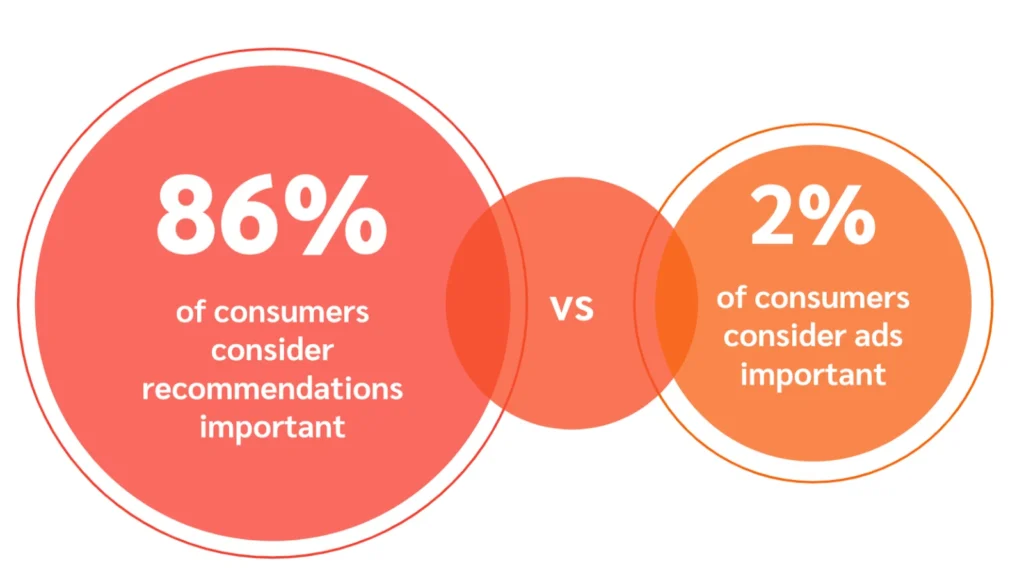
Source: Customer referral marketing research: A consumer perspective
Metrics to measure
- Referral traffic: Monitor the traffic coming to your site, specifically from referral links.
- Clicked share links: Track the number of clicks on each referral link.
- Social shares: Count how often your customers have shared their referral links on social media.
- Program impressions: Track how many customers have seen/loaded your program. This could be how many customers have loaded your program’s widget.
Defining customer acquisition targets and metrics
Acquiring new customers can be expensive and unpredictable. Referral marketing flips the script. Instead of relying on potentially low-quality or infrequent leads, referral marketing brings high-quality leads through trusted recommendations. For example, RealtyNinja’s referral program achieved double the conversion rate of their paid search ads.
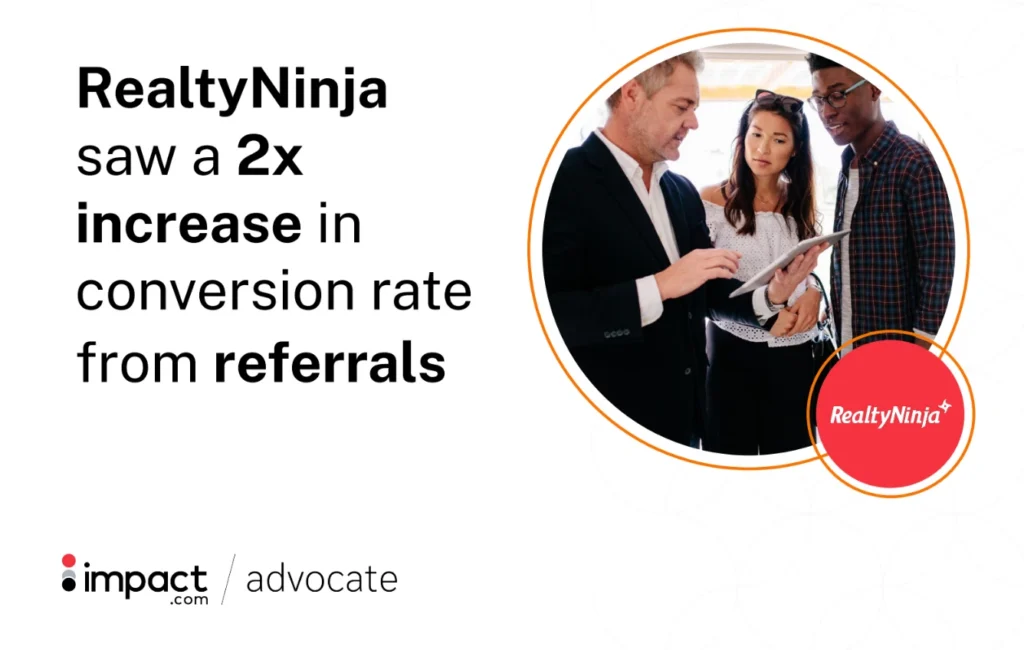
RealtyNinja case study: With the help of impact.com/advocate, Realty Ninja launched a double-sided program that achieved a significant increase in customer acquisition via referrals
Metrics to measure
- Referral conversion rate: Of the users who arrive via a referral link, what percentage make a purchase or sign up?
- Cost per acquisition (CPA): Evaluate the expense (including rewards or incentives) associated with acquiring a new customer through the program.
- Number of leads or new customers: How many new leads or customers come through your referral program?
- Revenue generated: Track the revenue generated from your program.
- Total reward cost per referral: How much does it cost to reward each successful referral?
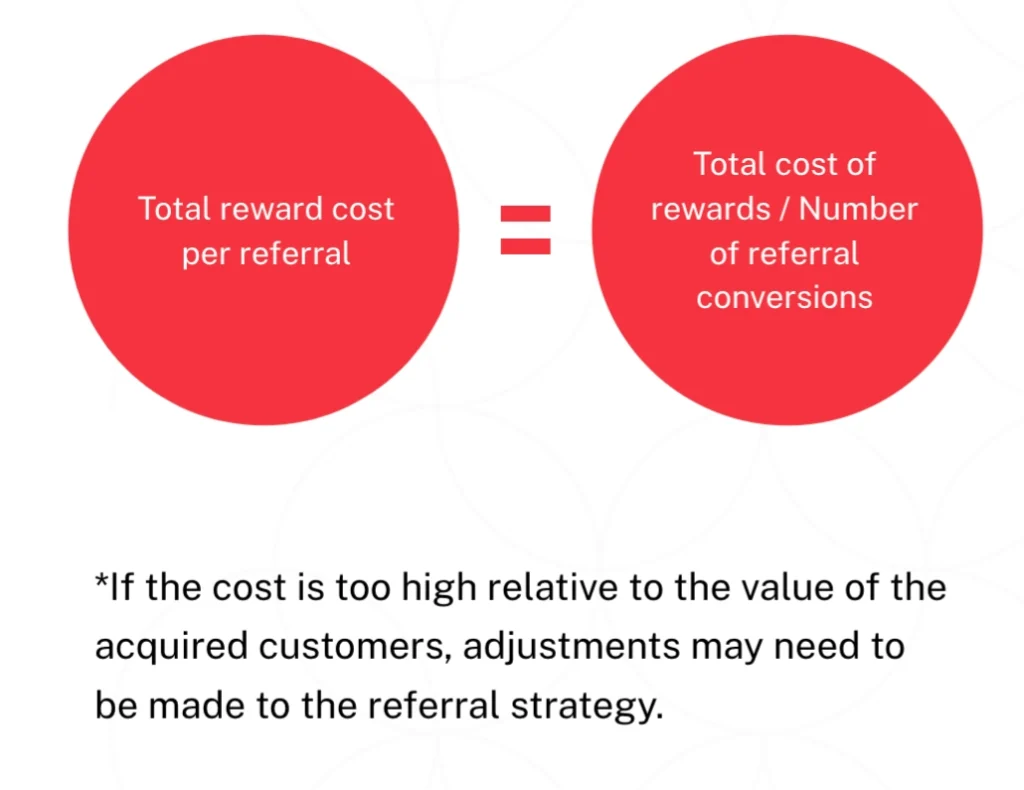
Creating customer retention goals that drive long-term growth
Effective word-of-mouth programs go beyond bringing in new customers—they help keep your existing ones loyal. Offering rewards for referrals shows that you value your customers and strengthens their connection to your brand.
Metrics to measure
- Repeat purchase rate: How frequently do referred customers make subsequent purchases after their initial purchase?
- Customer lifetime value (CLV): Calculate the average revenue a referred customer generates throughout their engagement with your brand.
2. Designing an effective referral reward structure that drives results
A well-designed program starts with clear rules and reward structures. The right incentives motivate participation and align the program with business goals.
Here are the main types of reward structures you can use to engage your audience.
Choosing between single-sided and double-sided rewards
Single-sided program
A single-sided program rewards only one party—either the referrer (promoter) or the referred person. It’s a straightforward, cost-effective, and easy-to-manage structure, making it a practical choice for many businesses. However, it’s crucial to consider which party to incentivize to maximize effectiveness.
While 96 percent of programs reward the existing customer in a single-sided program, rewarding the new customer may be more efficient at gaining new customers.
Why reward the referred person?
Research by Rachel Gershon, referral marketing expert and Assistant Professor of Marketing at the Rady School of Management, reveals why rewarding the new customer makes more sense.
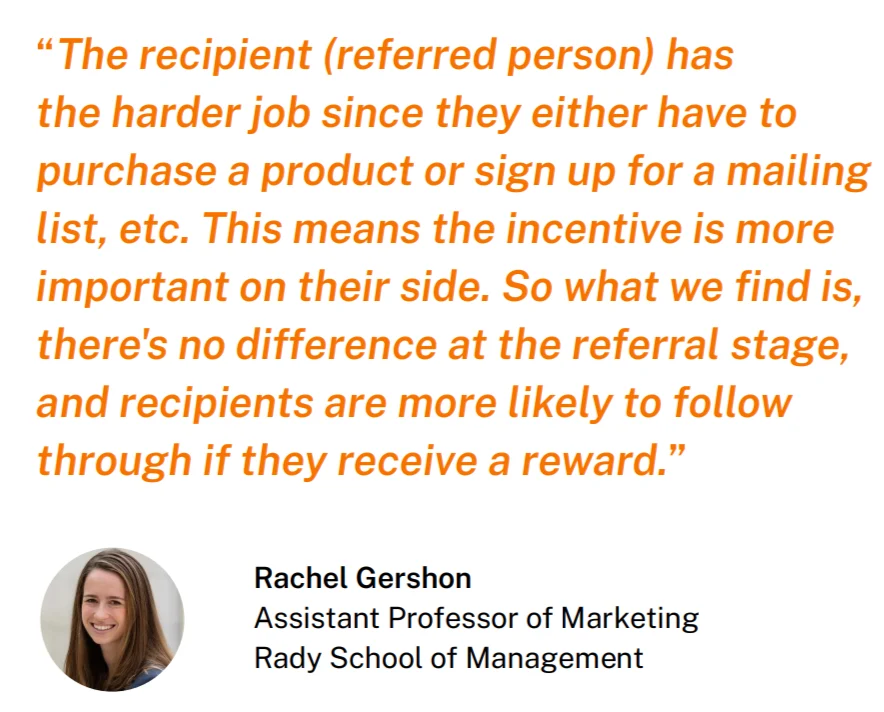
Pros:
- Easy to implement and manage: With only one party to reward, the process is simpler to set up, monitor, and maintain.
- Cost-effective: Limiting rewards to one party minimizes expenses and makes costs predictable—ideal for smaller budgets or pilot programs.
Cons:
- Unrewarded parties lack motivation: Without incentives, the referrer might feel unappreciated, or the referred person might not be compelled to take action.
- Limited reach and engagement: When one party is excluded from rewards, the program may not generate as much enthusiasm or word-of-mouth momentum.
When you reward the referred person, your single-sided program may generate higher conversions and better results.
Double-sided program
Double-sided programs create a win-win scenario by rewarding both the referrer and the referred person. A mutual incentive encourages participation from both sides, making these programs more appealing.
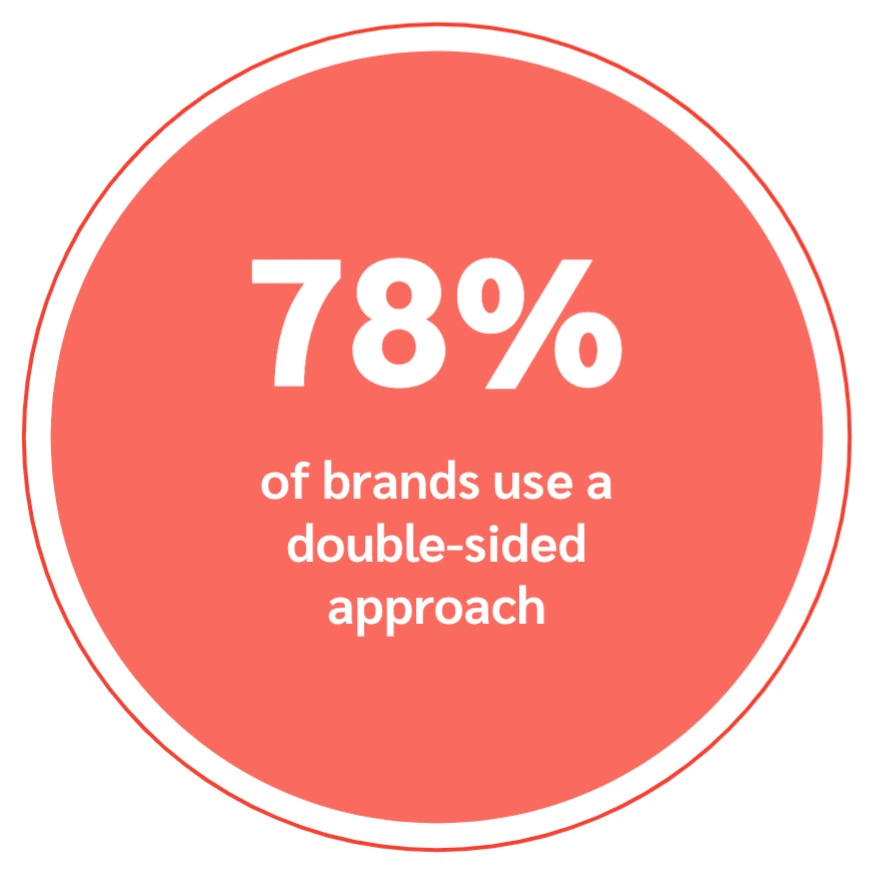
Source: The state of referral marketing report 2024
Pros:
- Mutual motivation: Both parties have clear reasons to participate—the referrer wants to share the reward, and the referred person is incentivized to act.
- Boosts engagement and advocacy: Referrers are more likely to actively promote when they feel rewarded, while referred customers are more likely to convert due to the additional incentive.
- Stronger relationships: Rewarding both sides fosters goodwill and creates a positive association with your brand, increasing loyalty and advocacy.
Cons:
- More difficult to manage: These programs reward both parties, making it more challenging to manage and track referrals.
- More costly: Rewarding both parties means brands may pay up to double the cost vs a single-sided program.
Although double-sided programs cost more and are harder to manage, they often drive better engagement and results—a key benefit for brands aiming to grow through referrals. Plus, using an advanced referral marketing platform can make the process a breeze.
Gated program
A gated refer-a-friend campaign requires participants to meet specific criteria before they can refer others. For example, they might need to sign in to their account or use a mobile or desktop app to refer.
It’s especially effective for brands with a highly engaged customer base that interacts within a secure, gated environment, such as a dedicated app or platform.
Pros:
- Delivers higher-quality leads: Referrals come from verified customers, increasing the likelihood of authentic and relevant leads.
- Reduces fraud risk: The extra required step helps prevent misuse and ensures only legitimate participants can refer others.
Cons:
- Can create barriers to participation: The additional steps may discourage some users from participating, especially if the process feels inconvenient.
- Limits accessibility: It works best for brands with an existing, active customer base already interacting in a gated environment.
Gated programs take more effort to set up but are perfect for brands prioritizing quality over quantity in referrals.
Ungated program
Ungated referral programs let anyone make referrals without restrictions. Taking an inclusive approach makes it easy for participants to share and earn rewards, even if they aren’t logged into an account.
It’s an excellent fit for brands, where customers typically interact outside a gated environment, such as ecommerce websites.
Pros:
- Simple and inclusive: Anyone can participate, so it’s easier to attract a wider range of referrals.
- Encourages engagement: With fewer barriers, participants are more likely to share and refer.
Cons:
- Higher risk of fraud: Without verification steps, the program may be more susceptible to fraudulent activity.
- Potentially lower lead quality: Open access could lead to referrals from individuals less connected to your brand.
Ungated programs are ideal for brands seeking to maximize participation, but they require careful monitoring to maintain the quality of referrals.
Tiered program
A tiered word-of-mouth program offers participants different rewards based on specific actions or milestones. Tiers are typically designed around key behaviors you want customers to engage in, such as referring others to purchase a product or signing up for a specific plan.
By providing multiple reward options, tiered programs accommodate diverse audiences and their needs, boosting the chances of referrals. Brands can also reward referrers based on their performance, like reaching certain referral milestones.
Pros:
- Flexibility for participants: Offering multiple reward options appeals to a wider range of customers and increases engagement.
- Encourages higher-value actions: Tiered rewards incentivize actions that align with your business goals, such as purchasing premium products or plans.
- Drives sustained participation: As referrers aim to reach higher tiers, they stay motivated to make more referrals.
Cons:
- More complex to manage: Tracking multiple tiers and rewards requires careful planning and robust systems.
- Risk of overwhelming participants: Too many options can confuse users or dilute the program’s impact.
Tiered programs work well for brands looking to target varied customer behaviors and reward both one-time and long-term referrers.
Leaderboards
Leaderboards add a fun, competitive edge to your program by rewarding top performers.
Participants are motivated to climb the ranks and earn bonus rewards for hitting specific milestones. For example,
Pros:
- Boosts engagement: Competition drives participants to refer more frequently to climb the leaderboard.
- Encourages long-term participation: Milestone bonuses keep users motivated to stay active over time.
- Creates social buzz: A visible leaderboard can generate excitement and inspire others to join.
Cons:
- Might discourage casual users: Participants who feel they can’t compete with top referrers may lose interest.
- Risk of focusing on quantity over quality: Competitive participants might prioritize referrals over the quality of leads.
Leaderboards work best for brands with an engaged audience that thrives on competition and rewards-based challenges.
Reward exchanges
Reward exchange programs let participants choose their preferred reward from a curated list, such as discounts, loyalty points, or free gifts. Flexibility makes the referral program more appealing by allowing users to select rewards that best suit their preferences, boosting participation and satisfaction.
Pros:
- Enhanced appeal: Participants are more likely to engage when they can choose a reward they value.
- Improved satisfaction: Offering options ensures that rewards align with individual preferences, creating a more positive experience.
- Flexible implementation: Rewards can be tailored to your audience, from monetary incentives to exclusive perks.
Cons:
- Increased complexity: Managing multiple reward options can require more effort and careful tracking.
- Higher costs: Offering a variety of rewards may be more expensive compared to single-option programs.
Reward exchanges are ideal for brands looking to provide a personalized referral experience that resonates with a diverse audience.
Time-based offers
Time-based offers reward participants for completing referral actions within a specific timeframe. These limited-time campaigns create urgency and encourage customers to act quickly, by offering enhanced rewards during the promotional period.
Pros:
- Creates urgency: The limited timeframe motivates participants to act immediately.
- Boosts engagement: They grab attention and encourage customers to share your program more actively.
- Increases revenue during slow periods: Well-timed campaigns help generate a surge in sales when business is slower.
Cons:
- Short-lived impact: Once the promotional period ends, engagement may drop.
- Potential pressure on participants: Some customers might feel overwhelmed by time constraints and choose not to participate.
Time-based offers are an effective way to create excitement and drive results quickly, especially during seasonal lulls or product launches.
Types of referral rewards that motivate customers
Next, you need to choose the right reward type for your program. The best reward type depends on your budget and what motivates your audience.
Here are four reward types to keep in mind:
1. Cash rewards
Cash rewards are monetary incentives given to participants for successful referrals. The simplicity and universal appeal of cash make it a powerful motivator for driving engagement.
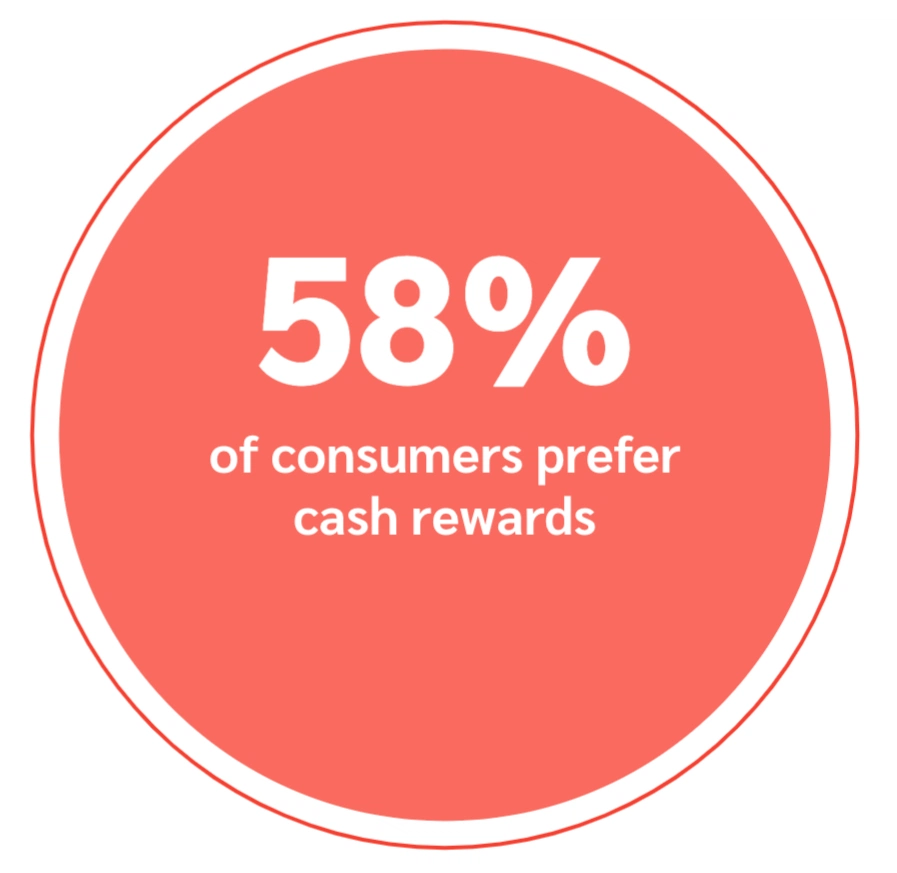
Source: Customer referral marketing research: A consumer perspective
Pros:
- Universal appeal: Everyone values cash, making it a compelling incentive for broad audiences.
- Easy to understand: Cash rewards are straightforward and don’t require explanation, reducing barriers to participation.
- Flexibility for recipients: Participants can use the reward however they choose, enhancing satisfaction.
Cons:
- Higher upfront cost: Cash rewards can be more expensive compared to non-monetary options like discounts or points.
- Lacks brand connection: Unlike branded perks or gifts, cash doesn’t create a lasting association with your business.
- May attract less loyal customers: Some participants might refer purely for the cash incentive, instead of genuine brand affinity.
PayPal runs campaigns where users receive cash for referring friends to sign up and use the platform. Once the new user creates an account and completes a qualifying transaction, the referrer and the referred user could earn a cash reward of $10 each.
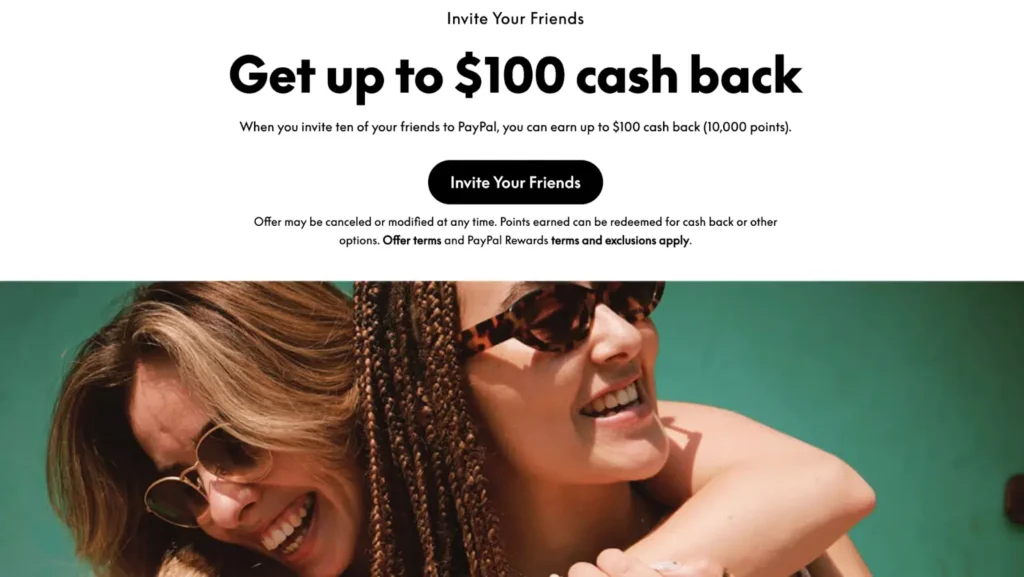
Source: PayPal referral landing page
2. Discount
A percentage discount offers customers a reduction in the price of a product or service as a reward for referrals. With 26 percent of consumers preferring discounts, this type of incentive appeals to cost-conscious participants and encourages them to engage with your program.
A great example of an ecommerce referral program is ASOS, a global fashion retailer. The brand offers a discount-based reward, where both the referrer and the referred friend receive a percentage discount on their next purchase. The referrer gets a 20 percent discount after their friend makes their first purchase, and the friend gets the same discount on their first order.
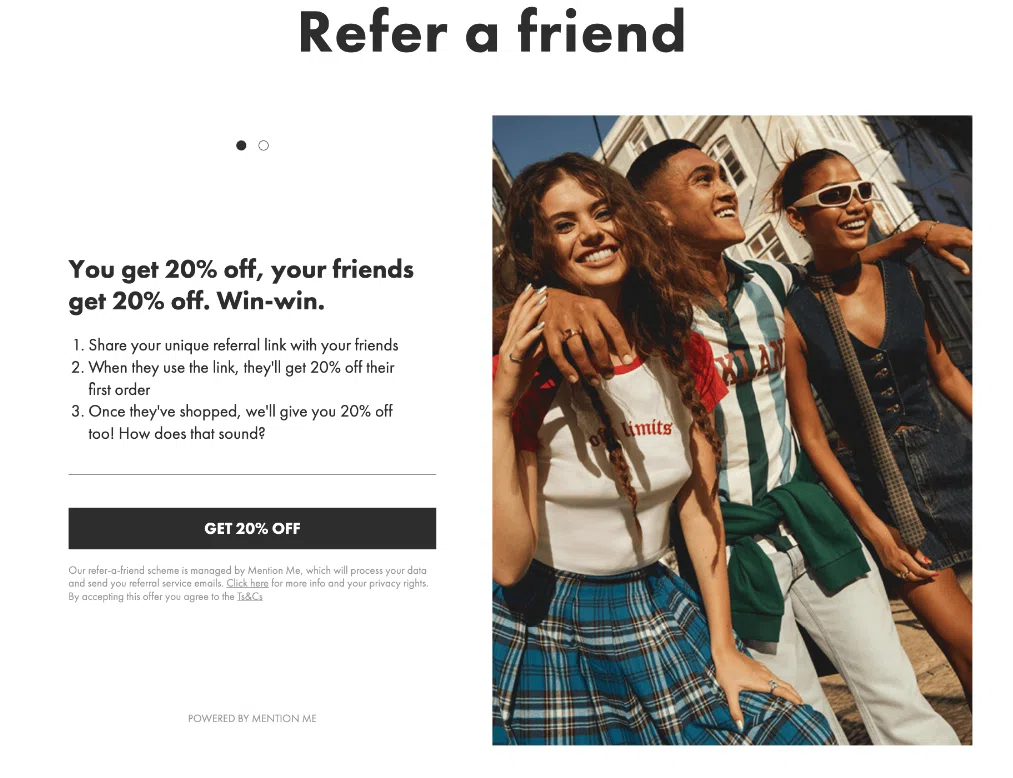
Source: ASOS referral landing page
Pros:
- Encourages repeat purchases: Discounts motivate customers to shop again, fostering loyalty.
- Cost-effective for businesses: The reward value adjusts based on the item’s price, making it easier to manage costs.
- Easy to implement: Simple to understand and promote, requiring minimal explanation.
Cons:
- Limited perceived value for low-cost items: If the discount applies to a small purchase, it may not feel as impactful.
- Less memorable than cash or unique perks: A discount might not create a strong connection to your brand.
- Can erode brand value if overused: Frequent discounts may make customers expect them, reducing their willingness to pay full price.
3. Points
Points rewards allow participants to earn loyalty points for successful referrals, which they can redeem for future purchases, exclusive perks, or other rewards. This reward is a popular way to incentivize referrals while encouraging ongoing engagement with your brand.
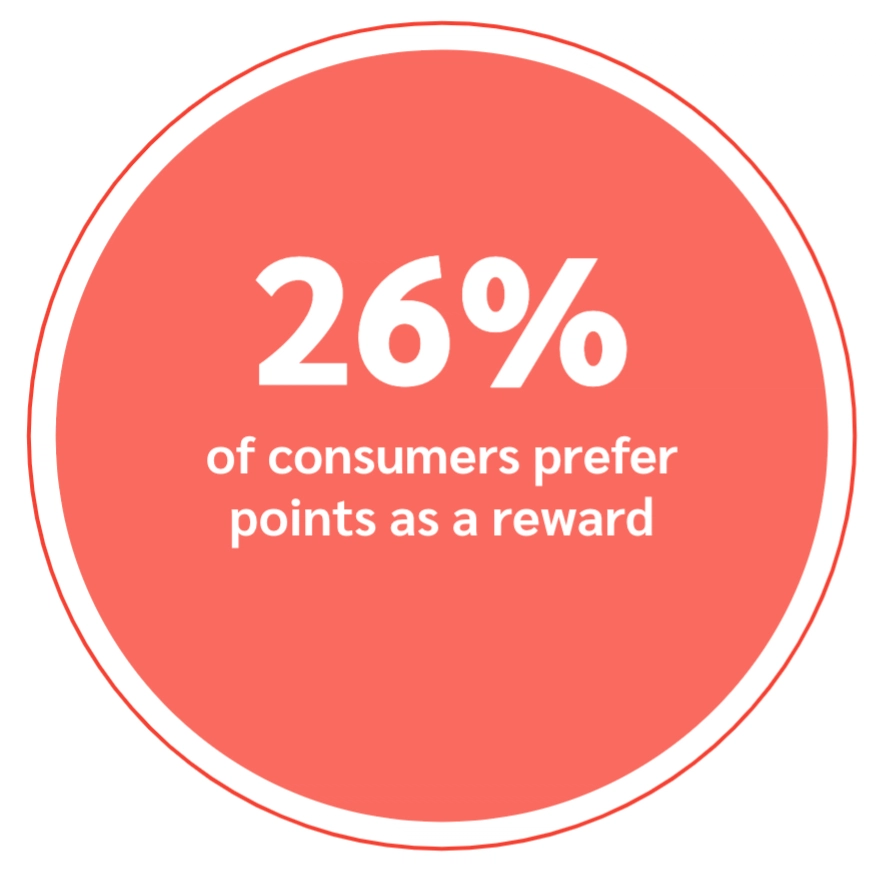
Source: Customer referral marketing research: A consumer perspective
As part of Sephora’s Beauty Insider loyalty program, the brand allows customers to earn points for various activities. The points that can be redeemed for discounts, exclusive products, or perks like free shipping and samples.
Source: Sephora’s Beauty Insider landing page
Pros:
- Builds long-term engagement: Points encourage repeat interactions as participants accumulate and redeem them.
- Customizable rewards: Points can be redeemed for various options, making them flexible and appealing to different customer preferences.
- Cost efficiency: Businesses can control redemption values and manage costs effectively.
Cons:
- Delayed gratification: Customers may lose interest if the path to redemption feels too long or complex.
- Requires clear communication: Participants need to understand the value of points and how to use them, which adds complexity.
- Potentially less exciting: Compared to immediate rewards like cash or discounts, points may feel less compelling for some participants.
4. Custom rewards
Custom rewards allow participants to choose or receive personalized incentives tailored to their preferences. These rewards could range from exclusive experiences to branded merchandise or curated gifts, creating a unique and memorable experience.
Pros:
- Highly personalized: Custom rewards create a sense of exclusivity and thoughtfulness, leaving a lasting impression.
- Strengthens brand connection: Tailored rewards help build a deeper emotional connection with your brand.
- Encourages loyalty: Participants are more likely to engage with a program offering meaningful, personalized incentives.
Cons:
- Complex to implement: Designing and managing custom rewards requires additional effort and resources.
- Higher costs: Personalized rewards can be more expensive than standardized options.
- Risk of mismatched expectations: If the reward doesn’t align with participants’ preferences, it could lead to dissatisfaction.
Custom rewards are ideal for brands aiming to stand out and create a unique referral experience that fosters strong relationships with customers.
How to structure tiered and milestone-based rewards
When designing a referral program, brands must align reward types with their industry and audience. Different sectors have unique dynamics, and certain rewards may resonate better with specific customers. Understanding these nuances can make or break your program’s success.
Take your industry into account
Every industry has distinct characteristics that shape how referral programs should be executed. While the principles of referral marketing remain the same, the approach varies based on customer behavior, purchase patterns, and product types.
For example, take a look at these different industries:
- SaaS (software as a service): Word-of-mouth programs in SaaS rely heavily on a subscription-based user base. These brands often use double-sided rewards to incentivize both the referrer and the referred person. According to the State of Referral Marketing report, 69 percent of SaaS referral programs are double-sided, with rewards ranging from $5 to $500. These programs focus on driving customer acquisition, usage, and retention, making balanced incentives crucial.
- Electronics: Over 50 percent of consumers rely on referrals when purchasing electronics, but only 24 percent refer to these products through official programs. High price points and infrequent purchases in this sector make traditional referral incentives less effective. A better approach might involve exclusive discounts or extended warranties as rewards.
- Professional and in-person services: Nearly half of consumers (49 percent) seek recommendations for services like salons, fitness trainers, or consultants, but only 27 percent use refer-a-friend programs. Custom rewards, such as free trials or discounted packages, may resonate more with this audience than cash incentives.
3. Making it easy for customers to refer your business
Your program’s success depends on how easy and enjoyable it is for customers to use. If making a referral feels complicated or time-consuming, users will likely abandon it.
Here’s how to reduce friction and create a seamless experience for both the referrer and the referred.
Designing a user-friendly referral interface
A well-placed, intuitive widget encourages customers to effortlessly promote your brand. Think of it as your referral program’s landing page—clear, inviting, and effective.
Don’t just set it and forget it. Continuously refine the experience to keep users engaged.
- Make it intuitive: Include essential features like referral links, codes, and sharing buttons, all accessible with minimal clicks.
- Be transparent: Use a dashboard to show the status of referrals, giving users confidence in the program while reducing support tickets. Most referral-related inquiries come from users asking, “What happened to my referral?” or “Did my friend sign up?”
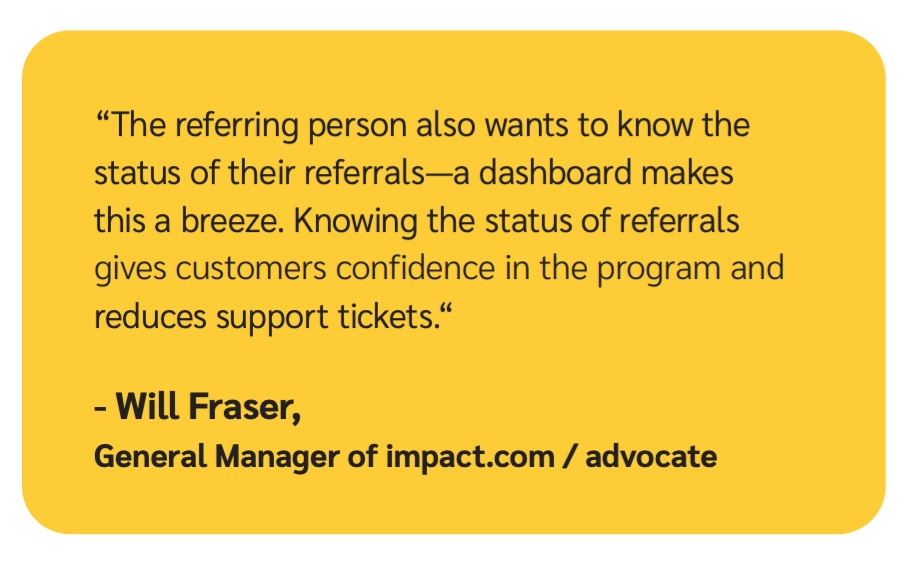
Simplifying the customer referral process
Customers want a smooth experience. If they encounter too many hurdles—like creating a new account or navigating through multiple pages—they’ll likely give up.
- Single sign-on (SSO): Allow users to log in with their existing social or email accounts to streamline processes.
- Pre-populated text templates: Help users share your offer by providing ready-made copy for emails or social posts. This saves them effort and ensures your messaging stays on-brand.
Building engaging customer referral touchpoints
Treat your widget like a marketing asset that captures attention and inspires action.
- Use catchy copy: Play with alliteration, humor, or puns to make the program memorable.
- Experiment with visuals: Test bold designs and enticing imagery to see what resonates. RingCentral sparks interest with alliteration, bold colors, exciting rewards, and a chance to win a trip to Hawaii.
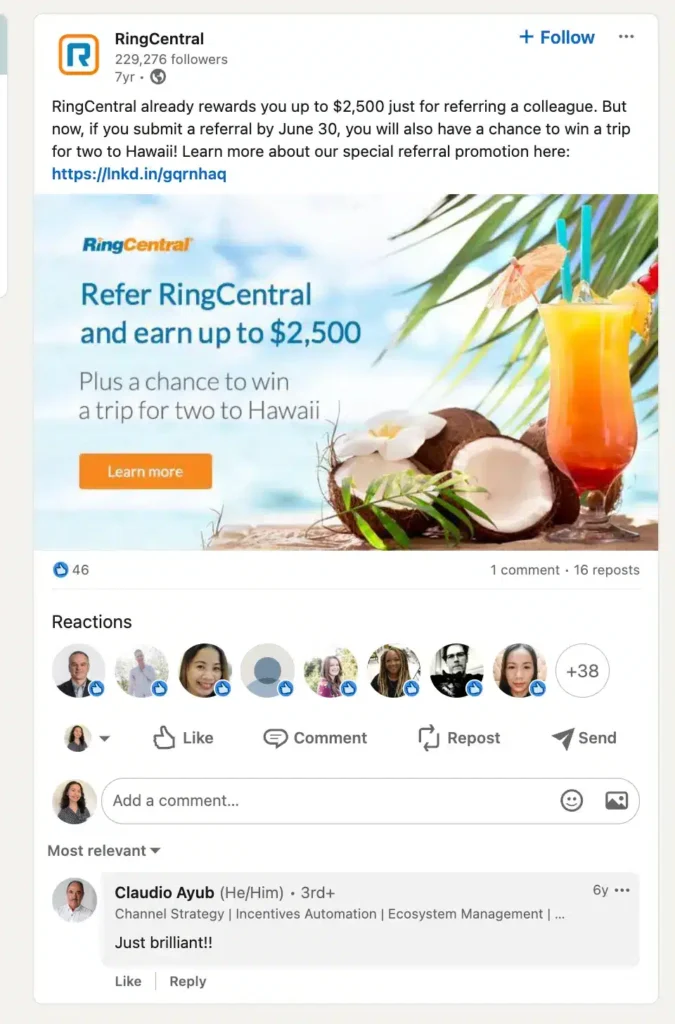
4. Creating compelling referral program messaging that converts
A successful word-of-mouth campaign hinges on clear, engaging messaging that resonates with your audience. Every element—from the offer to the call-to-action (CTA)—should captivate and drive action. Here’s how to optimize your messaging for maximum impact.
Writing high-converting copy to attract customers
- Highlight the benefit: Clearly communicate what’s in it for your audience. Whether it’s a discount, freebie, or exclusive access, make the reward obvious and enticing.
- Be concise: Attention spans are short. Stick to brief, impactful messaging that gets straight to the point.
- Add urgency: Time-sensitive language like “Offer ends soon” or “Limited-time reward” prompts quicker action.
- Make it personal: Use a friendly, human tone, and consider personal touches like names to make your message feel relatable.
Crafting effective referral program headlines
Your headline is your first impression, so make it count.
- Focus on benefits: Use headlines like “Give $20, Get $20” to instantly highlight the reward.
- Ask a question: Engage readers with curiosity, like “Want a free month of premium access?”
- Use power words: Words like “exclusive,” “instant,” and “bonus” can make your offer feel irresistible.
- Add personalization: Headlines such as “Your exclusive invite” make users feel valued.
Pro tip: A/B test different headlines to see which drives the most engagement.
Designing action-driven CTAs to earn more referrals
The CTA is the most critical element of your messaging—it’s the moment customers decide to take action.
- Be direct: Use action-oriented phrases like “Share Now,” “Invite a Friend,” or “Claim Your Bonus.”
- Stand out visually: Use bold fonts, contrasting colors, or subtle animations to draw attention.
- Add urgency: Time-bound CTAs like “Claim Within 24 Hours” create a sense of FOMO.
- Position strategically: For maximum visibility, put the CTA above the fold on webpages and prominently placed in emails.
- Keep it singular: Focus on one clear action to avoid overwhelming your audience.
Testing and optimizing messaging
Your messaging should evolve based on audience preferences.
- Experiment with different tones, visuals, and reward structures to find what resonates.
- Continuously test and optimize CTAs, headlines, and designs to improve results.
A well-crafted referral program isn’t just about rewards—it’s about how you communicate them. When your messaging is clear, engaging, and tailored to your audience, you’ll attract high-value customers and inspire them to share your brand enthusiastically.
5. Promoting your referral program across multiple channels
A successful program starts with making sure customers know it exists. Often, companies overlook this step, treating their program as an afterthought, not a key marketing effort. Visibility is critical—if your program is hard to find, participation will suffer.
Integrating referrals into existing marketing channels
For maximum awareness, incorporate your program into your existing communication channels. Promote it through blog posts, newsletters, your company app, and social media to ensure it reaches a wide audience.
For example, you could add your program to:
- Blogs: Write optimized posts explaining the program, its benefits, and how users can participate.
- Newsletters: Add a referral CTA to your email campaigns, encouraging subscribers to share with their network.
- Apps: Integrate a referral widget in your app, making it easy for users to directly share links.
- Social media: Use posts, stories, and ads to highlight rewards and generate excitement.
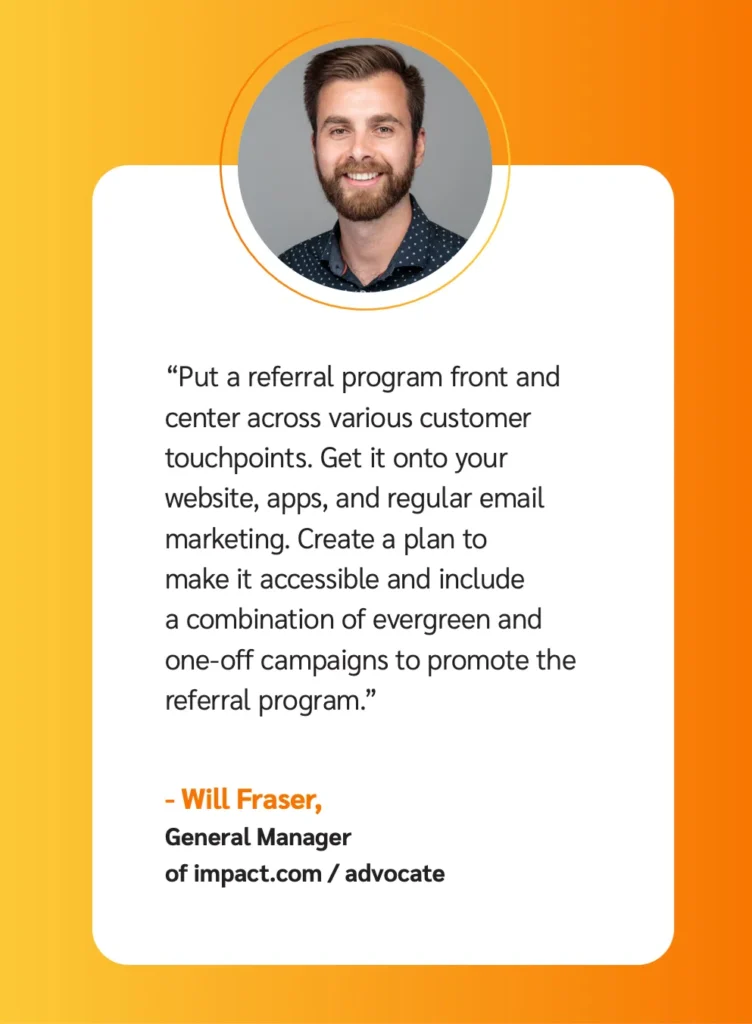
Training sales teams to drive word-of-mouth
Your sales and customer success teams interact with both new and existing customers—making them invaluable promoters of your referral program. Train them to:
- Highlight the benefits of the program during conversations
- Educate customers on how to sign up and participate
Creating an effective program landing page
A dedicated referral program page on your website makes it easy for customers to understand the program and get involved. Your explainer page should:
- Clearly explain how the program works
- Highlight the benefits of participating
- Include the terms and conditions in simple language
- Use visuals or videos for added clarity
For example, Nintendo’s explainer page features a well-illustrated summary oÿ the reward collection and redemption process.
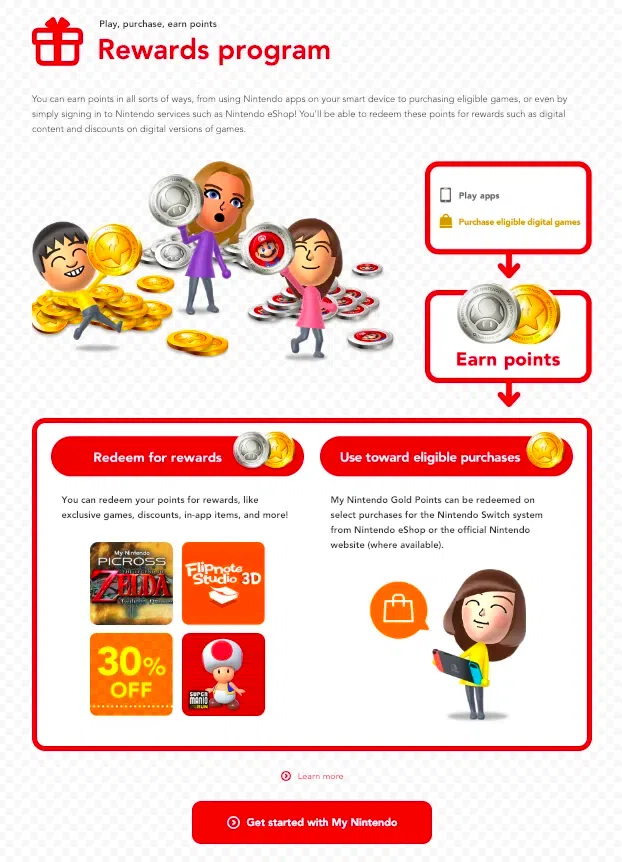
Source: Nintendo explainer landing page
6. Measuring and tracking referral program performance
Tracking your program’s performance is essential for ensuring its effectiveness and optimizing results. Tools like impact.com/advocate make it easy to monitor key metrics and fine-tune your strategy based on data-driven insights.
How to effectively track your program:
- Use real-time tools: Platforms with real-time dashboards provide granular insights, such as referral clicks, conversions, and rewards earned.
- Define clear metrics: Identify what success looks like—whether it’s total referrals, conversion rates, or customer lifetime value from referred clients.
- Monitor regularly: Establish a routine for reviewing performance metrics to identify trends, peak times, and areas for improvement.
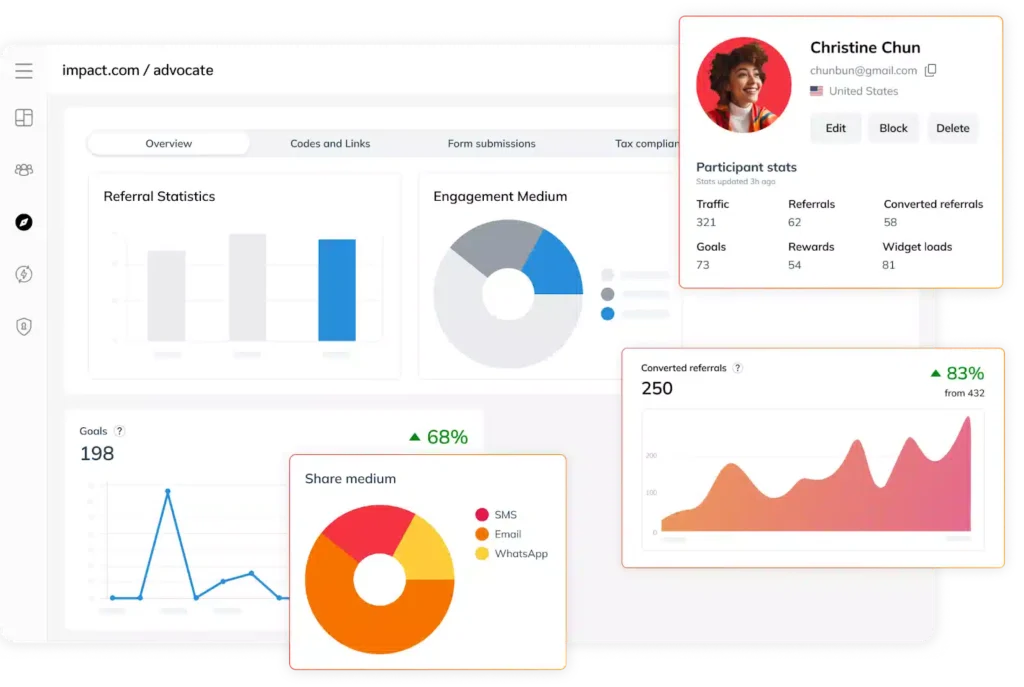
Top features of advanced referral software:
- Unique referral links: Accurately attribute referrals to the right users.
- Real-time insights: View up-to-date data on program visibility, referral completion, and revenue generated.
- Fraud detection: Safeguard program integrity by identifying suspicious activities.
- Customizable rewards: Set conditions for rewards, such as only granting incentives after purchases or sustained engagement.
- Integration capabilities: Combine referral software with CRMs and marketing tools for a complete view of referred customer behavior.
7. Optimizing your referral program with data-driven insights
Your referral program isn’t a ‘set-it-and-forget-it’ strategy. Like any successful marketing initiative, it requires regular evaluation and optimization to remain effective. To fine-tune a program driven by human recommendations, the key lies in leveraging data to make informed decisions.
Here’s how to optimize your refer-a-friend program step by step.
Analyzing key performance trends for your customer advocacy program
Your analytics tell a story—listen carefully. Focus on metrics such as:
- Referral conversion rates
- Average lifetime value of referred customers
- Number of active referrers
These insights help identify what’s working and where adjustments are needed.
Segmenting and studying customer behavior
Not all referrers or customers are the same. Segment your data to uncover trends:
- Which demographics refer the most?
- Who converts most effectively?
- Which groups need extra encouragement?
Tailor your strategy to align with the behaviors and preferences of each segment.
Gathering and implementing feedback
Ask referrers and referred customers for input. Learn:
- What they enjoyed about the program
- What motivated them to participate
- Where they encountered friction
This feedback is invaluable for identifying opportunities for improvement.
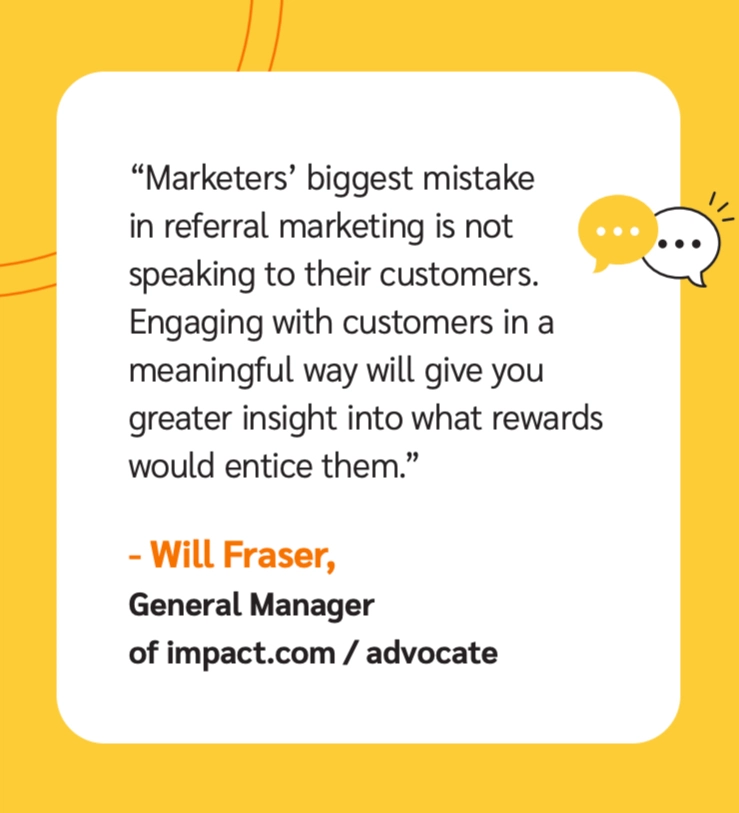
Refreshing incentives based on customer insights
What motivated your audience six months ago might no longer appeal today. Regularly evaluate your rewards to ensure they remain attractive and aligned with your audience’s expectations.
With the Optimize feature on impact.com/advocate, you can:
- Pull detailed reports from the analytics dashboard to measure performance
- Monitor key metrics like revenue and engagement
- Demonstrate ROI and confidently make data-driven decisions
Put your referral program strategy into action
A successful word-of-mouth program isn’t a one-time effort—it’s an ongoing process of engagement and alignment with customer expectations. By analyzing data, refreshing incentives, and ensuring a seamless experience, your program can remain relevant and drive lasting results.
Ready to take your referral program to the next level? Request a free demo of impact.com/advocate.
FAQs
u003c!u002du002d wp:paragraph u002du002du003ernrnHere are four key steps to follow when creating a referral program:rnrnu003c!u002du002d /wp:paragraph u002du002du003e u003c!u002du002d wp:list {u0022orderedu0022:true} u002du002du003ernu003col class=u0022wp-block-listu0022u003ern tu003cli style=u0022list-style-type: none;u0022u003ernu003col class=u0022wp-block-listu0022u003eu003c!u002du002d wp:list-item u002du002du003ern tu003cliu003eStart by defining your goals and audience.u003c/liu003ernu003c/olu003ernu003c/liu003ernu003c/olu003ernu003c!u002du002d /wp:list-item u002du002du003e u003c!u002du002d wp:list-item u002du002du003ernu003col class=u0022wp-block-listu0022u003ern tu003cli style=u0022list-style-type: none;u0022u003ernu003col class=u0022wp-block-listu0022u003ern tu003cliu003eChoose software to track referrals, set clear rules, and design appealing rewards for referrers and new customers.u003c/liu003ernu003c/olu003ernu003c/liu003ernu003c/olu003ernu003c!u002du002d /wp:list-item u002du002du003e u003c!u002du002d wp:list-item u002du002du003ernu003col class=u0022wp-block-listu0022u003ern tu003cli style=u0022list-style-type: none;u0022u003ernu003col class=u0022wp-block-listu0022u003ern tu003cliu003ePromote your program through email, social media, and your website to encourage participation.u003c/liu003ernu003c/olu003ernu003c/liu003ernu003c/olu003ernu003c!u002du002d /wp:list-item u002du002du003e u003c!u002du002d wp:list-item u002du002du003ernu003col class=u0022wp-block-listu0022u003ern tu003cli style=u0022list-style-type: none;u0022u003ernu003col class=u0022wp-block-listu0022u003ern tu003cliu003eRegularly review performance and adjust to improve results.u003c/liu003ernu003c/olu003ernu003c/liu003ernu003c/olu003e
Outline clear referral guidelines and rewards for employees. Use software to track referrals and ensure transparency. Communicate the program through internal channels, making it easy for employees to participate. Regularly update and recognize employees for successful referrals to keep engagement high.
Encourage loyal customers or employees to refer others by offering incentives like discounts or cash rewards. As referrals bring in new customers, you generate revenue through increased sales or conversions. Optimize your program with data insights to maximize profitability.







